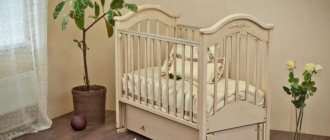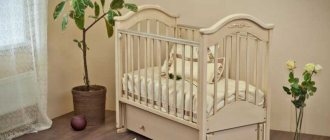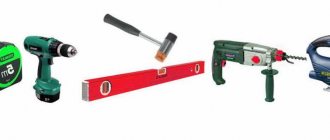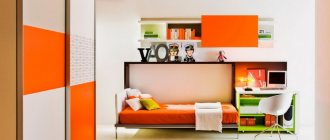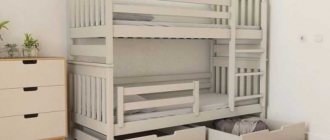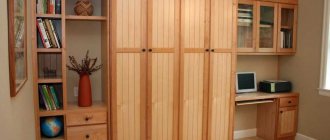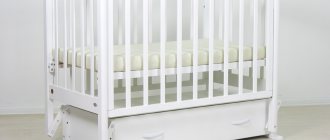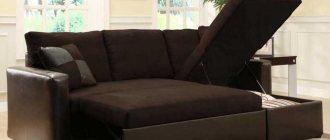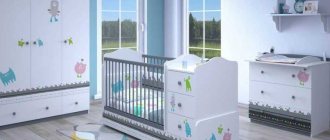When arranging a bedroom or children's room in a small apartment, people spend a lot searching for a suitable bed model.
After all, such furniture should be compact, comfortable to use and aesthetically pleasing. An excellent solution for small rooms would be to choose a transformable bed. The cost of finished products in furniture stores is quite high. Therefore, we suggest making a transforming bed with your own hands. This way you will not only save your own savings, but also make furniture that will suit you in terms of the type of design, dimensions and appearance.
Advantages for a small apartment
The main advantages of transformable furniture include:
saving free space . These designs are ideal for small apartments where it is not possible to install massive furniture;- functionality . During the daytime, they turn into a wardrobe with additional furniture items, and at night, they are transformed into a spacious sleeping area;
- variety . Transformer furniture, depending on the type of design chosen and materials of manufacture, will fit into classic and modern interiors. Their facades can consist of mirror surfaces, visually increasing the space.
Preparation of materials and cutting
Before starting the bed manufacturing process, you must have a drawing, following which you can make a wardrobe bed with or without additional shelves. A detailed diagram of the arrangement of parts will help you create a high-quality bed as quickly as possible that will function correctly.
Such schemes most often involve the production of beds with dimensions of 1800*2000, 2120*1715, 2040*2200, 1731*2020. This is how double beds are made. Single beds are most often intended for children's rooms, therefore they are smaller in size. Since they are installed independently, it is possible to create a drawing of the size of the bed depending on the availability of free space, the age of the child and the possible use of this bed by younger children after older children grow up. To create a transformable bed, the drawings must be as accurate and clear as possible.
To make a wardrobe bed with your own hands, you will need the following tools:
- Drill;
- Screwdriver;
- Jigsaw;
- Saw;
- File;
- Pliers;
- Roulette;
- Level;
- Screwdriver;
- Carpenter's pencil;
- Sandpaper with different abrasiveness numbers;
- Furniture screws;
- Self-tapping screws.
This is a minimum set of tools; others may be required during the work process.
Tools
You also need to have the following materials:
- Furniture boards or chipboards;
- Wooden beams;
- Wooden boards;
- Loops for fastening;
- Corners;
- Hinge mechanism;
- Decoration materials;
- Materials for making legs.
This is also a minimum set of materials. Cutting is carried out according to the drawing. This is done like this:
- Using a tape measure and a pencil, all the details of the future cabinet are made in the form of patterns according to the data from the drawing;
- For patterns, you can use joined sheets of whatman paper or wallpaper;
- Each element must be signed;
- Mark the connection points and fastening points of the transformation mechanism.
Materials
Design
According to the type of design, a transformable bed can be:
vertical . This product is a two-meter-long wardrobe, the head of which is fixed to the wall, and the sleeping place is hidden in the closet during the day;- horizontal . Such models are equipped with a single bed attached to the wall on the side;
- roll- out These are the most common models in which the lower built-in part slides out and forms a spacious sleeping area. Such models are suitable for arranging children's rooms and adult bedrooms;
- lifting _ This product is equipped with a pneumatic mechanism that easily allows you to remove the bed into a niche in a wall or cabinet.
In addition, the transformable bed can be a folding pouf. That is, when folded, the product is a regular pouf, and when unfolded, it is a small sleeping place. Round transformable beds are also popular, ideal for small children. They are safe because they have no sharp corners.
Help : children's models are often equipped not only with a sleeping place, but also with a sofa, chest of drawers and a work desk.
If there are two children in a family, it is recommended to install a transformable bunk bed in the room. This design has one mechanism by which the product folds and unfolds.
As for additional features, transformable beds are unique and versatile:
- beds for adults can be transformed not only into wardrobes and sofas, but also tables, chests of drawers, closed shelves;
- children's models are equipped with: changing tables, chests of drawers, drawers. Such products can be supplemented with lighting or a canopy.
Set of materials and tools
The most important element needed to make a folding bed is a lifting mechanism. On sale you can find mechanisms with different operating principles:
- mechanical;
- spring;
- on gas shock absorbers (gas lifts).
The last option is the most modern, with its help the transformer folds and unfolds without extra effort, the movement of the bed is smooth and silent, the bed is securely fixed in the desired position. The materials for making the stock must be selected in such a way that it is strong enough to withstand the weight of a person(s). At the same time, the folding bed should not be too massive so as not to create excessive load on the mechanism.
In addition to the mechanism for making a bed, you will need:
- timber with a section of 40x40 and edged board for the frame;
- sheets of plywood or slats for the bottom of the berth;
- Chipboard, if the cabinet will be made with a back wall;
- furniture panels made of laminated chipboard, MDF or solid wood for the sides and backs of the bed, box walls, cabinet facades. There are many companies where you can order the cutting of material into parts of the required size, as well as process their edges;
- furniture legs (if the bed will rest on them);
To determine the size of the parts, you need to focus on the dimensions of the mattress. The height of the box should be slightly greater than the length of the mattress; the thickness of the front and back walls of the bed should be added and a gap should be left. The width of the box is made 16 cm larger than the width of the mattress (space is needed to install a lifting mechanism).
The depth of the cabinet-box is usually equal to the height of the mattress + 32 cm. For the frame of the bed, you need to use a beam of such a size that the frame is slightly larger than the mattress, and it fits freely into the finished box. For the sides, front and back walls of the bed, you can take boards whose width is equal to the height of the mattress. It will protrude above their edges, since it will lie on the frame and the bottom fixed on top.
You will need strong belts to secure it, loops to secure the raised bed, fasteners - self-tapping screws, corners, possibly dowels, furniture fittings. If you purchase already cut materials, you can do without a jigsaw or saw, but a drill, screwdriver or screwdrivers are a must, a hammer will come in handy. You will also need tools for measurements and markings - a tape measure, a square, a pencil, a long rigid ruler, a level. Having decided on the design and location of the bed, as well as having prepared the necessary materials and tools, you can begin assembly.
Mechanisms
According to the transformation mechanisms, transformable beds can be equipped with the following lifting mechanisms:
manual _ This is the simplest and most affordable option. The bed is raised and lowered manually using physical force. This device has no shock absorbers or springs;- spring .
Thanks to the use of twisted springs, the service life of the lifting mechanism is more than half a century. But this mechanism makes unpleasant sounds over time due to stretching of the springs; - on gas lifts . This is the most convenient, but at the same time expensive option. To raise or lower the bed, you do not need to use force, since the mechanism will do everything itself.
Materials
As for the choice of materials, you can make a transformable bed on your own from:
- natural wood . This is the most expensive option. This product will delight owners with a long service life, beautiful texture, naturalness and environmental friendliness. But keep in mind, natural wood is quite difficult to work with. In addition to special equipment and tools, working with wood requires experience;
- Chipboard . This lumber attracts buyers with a wide range. Laminated chipboard has a rich color palette, various textures and textures. He is easy to work with. Laminated chipboard is suitable for those who have not previously had experience in making furniture;
- MDF . This material is environmentally friendly, easy to use, and durable. It is easy to process, and MDF furniture is aesthetically pleasing.
Drawings and diagrams
Before you start making and assembling a transforming bed, consider its dimensions, design, and materials of manufacture. All this must be put on paper with a pencil, not forgetting to indicate the connection points with fasteners.
You can make a drawing of a bed in different ways :
- independently, armed with a pencil and paper;
- using special computer programs that can be downloaded on the Internet;
- in a specialized company that manufactures furniture;
- download a ready-made diagram from the Internet and improve it according to your personal wishes.
Advice : if you order the production of a drawing from a specialized company, you will also receive product details along with it, which will simplify the manufacturing and assembly process.
How to make a transforming mechanism for furniture
There are plenty of types of lifting mechanisms on the market today. Let's consider the equipment that is used for beds. The most popular devices: mechanical and gas springs. The first ones work by tensioning springs. The second type is spring shock absorbers (gas lifts). There is also a hinge mechanism - a design where a person puts more effort into raising the bed.
At the moment, manufacturers offer many interesting options.
Making a folding device is not easy, but it is possible if you follow the instructions:
- We make the top rail (corner) from metal parts;
- the bottom rail is flat (attached to the box);
- it is necessary to connect the slats with two metal, moving (bolted) vertical slats, one larger in size;
- We buy, for example, a gas lift and attach it to a metal base.
The mechanism of transforming furniture wears out quickly, which can lead to its premature failure.
Important! It is better to buy this mechanism in a specialized store. The sofa bed is made by hand, and the device, as a rule, is purchased.
Tools
To make a transforming bed you will need the following materials :
MDF 2 cm thick;- plywood 1 cm thick;
- fittings and guides;
- PVC edge for trimming;
- lifting mechanism;
- self-tapping screws;
- glue;
- safety belt;
- magnetic buttons.
Tools that will be useful:
- meter;
- pencil;
- sandpaper;
- drill and drill bits;
- screwdriver;
- circular saw;
- perforator;
- anchor bolts;
- metal corners.
How to do it yourself?
After all the materials and tools are prepared, you can safely begin making a transforming bed:
First, a special box is made and a special platform is installed for the base of the bed, which is attached to the wall with anchor bolts.
For the frame we take two boards 2 meters long and one board 1.1 meters long. We connect the boards with screws and furniture glue . We wait until the structure dries, and attach the transverse one to the back side of the vertical boards. We fasten the board on the front side in the same way.- At the end of the box we fasten the side trim with screws and glue. We attach a crossbar to the top of the box . Now we proceed to the construction of the folding part. Before laying the mattress, the box should be reinforced with transverse and longitudinal slats, on which plywood will later be laid. This will prevent the plywood from sagging and give the box strength.
- The folding part of our bed will consist of plywood with triangular crossbars on the sides, fastened with a horizontal board. We fasten the structure with a special mechanism , with the help of which the product will unfold and fold.
- Now we move on to installing the fasteners and designing the box . To do this, we attach a loop at the top of the product through which the safety belt will be pulled. We place magnetic clasps in convenient places that will prevent the product from opening when lifted. We lay the mattress on the base and attach it to the plywood with glue.
- The final touch will be the installation of the legs .
Attention : the depth of the box must be equal to the thickness of the future bed. To be on the safe side, the box can be made deeper.
That's the whole process of making a transforming bed with your own hands.
DIY wardrobe bed
A simple and easy-to-make model that combines a wardrobe and a sleeping bed. The product consists of 3 parts, which are created separately and then combined into a folding structure. Before making a transforming bed with your own hands, you need to calculate the dimensions of the model and draw up a drawing with marked locations for fasteners. You can use ready-made diagrams or make a plan yourself, designing every detail.
The dimensions and shape of the bed base body depend on the required functionality and the size of the room. An important part of the transformer is a spacious niche for sleeping. When making the frame of a wardrobe-bed yourself, slabs (laminated or standard) are often chosen, since the material is unpretentious in processing and is affordable. You can order cutting of chipboard parts according to the required parameters from the manufacturer, in which case the edges of the elements will be processed with edging tape.
MDF or chipboard boards are attached to the bottom of the base; when assembled, they serve as the facade of the furniture. When designing elements, the interior design is taken into account. The rack and the bed are united by a lifting device. The mechanism carries heavy loads, so experts advise choosing high-quality systems. When making a wardrobe bed, you should also pay attention to the dimensional characteristics of the mattress and the availability of fittings.
Frame making
The transforming frame must hide a compact resting place, so it is made according to the calculated dimensions and configuration. The design should provide access to a spacious niche for the sleeping bed. When making calculations, it is important to take into account the parameters of the mattress so that the depth of the box matches the thickness of the bed. Experts recommend adding 2-3 cm to the required size.
The material used is easy-to-process chipboards. The parts are cut by the manufacturers to avoid chipping. You can order a ready-made frame from specialists, which will simplify installation work, but will cost more than doing the structure yourself.
The box contains several elements: baseboard, back wall of the cabinet, shelves for support. There are standard standards for the size range, but you can carry out an individual project - according to the author's design. In this case, accurate independent calculations will be required.
For the base of the frame, 2 boards are needed, which become load-bearing in the structure. The size of the beams is about 2 m. The beams are fixed at the top, bottom and along the edges with screws and glue. Cross boards add reliability. The finished frame is covered with cladding, the materials are fixed with adhesives. The parts are fastened using self-tapping screws or self-tapping screws, which are placed at a distance of 25 cm. Assembly work is carried out on a flat surface.
Making a folding part of the bed
The next stage is the installation of the folding part of the sleeping bed. The basis is plywood, sawn to the required dimensions. To avoid sagging and damage after installation, it is recommended to use 4 boards and add cross slabs. Additional sides will strengthen the sleeping bed. Additional elements must not interfere with the functioning of the lifting system.
When making a folding block, proper calculations are required to avoid overloading the box. The moving part should facilitate the design. The bed lifting mechanism can be represented by garage curtains, a solid axle, or axles with bearings.
It is important to ensure that the frame with the mattress is lifted and the structure is fixed vertically without physical effort. This requires spring blocks or counterweights. It is not necessary to make a lifting mechanism for a transforming bed yourself; the systems can be purchased ready-made.
Wall mount
The final stage is fastening the transformer frame to the wall. For long-term use, it is recommended to choose only high-quality fasteners. Reliable fixation is ensured by bolts or self-tapping screws, as well as metal slats.
For reliable fixation, you will need metal corners that are attached to the frame with anchors if the walls are brick or concrete. Self-tapping screws will be required for wooden houses.
Then the folding block is attached to the frame with hinges, and its free end is mounted with special fasteners, which ensure reliable fixation of the transforming bed when folded. Treatment of wood surfaces with varnish or stain is carried out before fixing the folding part to the wall.
The design can be folded in half when the bed is raised, so the furniture will take up less space in the room. Modified furniture can be supplemented, if necessary, with shelves and mirrors, making the product more functional.
Finishing
If desired, the inside and outside of the box can be covered with a special material that does not allow moisture to pass through.
To make it decorative, a wooden product can be coated with stain, varnished or painted .
To make the transforming bed look believable and resemble a real closet when folded, fittings are applied to the outside.
The end sides are decorated with PVC adhesive tape , which is applied to the product, heated with a hair dryer and pressed firmly.
Advice : if you are serious about saving space in your apartment, try making a lift-up bed, a wardrobe bed, an armchair bed or a loft bed. In addition, you may be interested in a folding or folding table.
